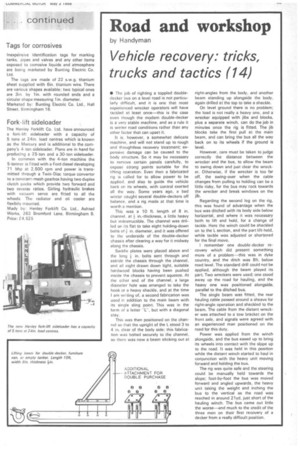Road and workshop
Page 71

If you've noticed an error in this article please click here to report it so we can fix it.
by Handyman
Vehicle recovery: tricks, trucks and tactics (14)
• The rob of righting a toppled doubledecker bus on a level road is not particularly difficult, and it is one that most experienced wrecker operators will have tackled at least once—this is the case even though the modern double-decker is a very stable machine, and as a rule it is winter road conditions rather than any other factor that can upset it.
It is, however, a somewhat delicate machine, and will not stand up to rough and thoughtless recovery treatment; expensive damage can be caused to the body structure. So it may be necessary to remove certain panels carefully, to expose strong points suitable for the lifting operation. Even then a fabricated rig is called for to allow power to be applied, and also to guide the vehicle hack on its wheels, with control exerted all the way. Some years ago, a bad winter caught several double-deckers off balance, and a rig made at that time is worth a mention.
This was a 10 ft. length of 8 in.
channel, at in.-thickness, a little heavy hut indestructible. The channel was drilled on its flat to take eight holding-down bolts of in. diameter, and it was offered to the underside of the double-decker chassis after clearing a way for it midway along the chassis.
Saddle plates were placed above and the long in. bolts sent through and astride the chassis through the channel, and all eight drawn down tight, suitable hardwood blocks having been pushed inside the chassis to prevent squeeze. At the other end of the channel, a large diameter hole was arranged to take the hook or a heavy shackle, and at the time I am writing of, a second fabrication was used in addition to the main beam with its single sling point. This was in the form of a letter "L", but with a diagonal stay.
This was then positioned on the channel so that the upright of the L stood 3 to 4 in, clear of the body side; this fabrication was bolted securely to the channel, so there was now a beam sticking out at right-angles from the body, and another beam standing up alongside the body, again drilled at the top to take a shackle.
On level ground there is no problem; the load is not really a heavy one, and a wrecker equipped with jibs and blocks, plus a separate winch, can do the job in minutes once the rig is fitted. The jib blocks take the first pull at the main beam, and can bring the bus all the way back on to its wheels if the ground is level.
However, care must be taken to judge correctly the distance between the wrecker and the bus, to allow the beam to swing down and just clear the wrecker. Otherwise, if the wrecker is too far off, the swing-over when the cable changes from pulling to holding can be a little risky, for the bus may rock towards the wrecker and break windows on the jib.
Regarding the second leg on the rig, this was found of advantage when the bus was ditched with its body side below horizontal, and where it was necessary both to lift and hold, for a change of tackle. Here the winch could be shackled on to the L section, and the part lift-held. while tackle was adjusted or shortened for the final move.
I remember one double-decker recovery which did present something more of a problem--this was in dyke country, and the ditch was aft. below road level. The standard drill could not be applied, although the beam played its part. Two wreckers were used; one stood away up the road for hauling, and the heavy one was positioned alongside, parallel to the ditched bus.
The single beam was fitted, the rear hauling cable passed around a sheave for right-angle operation and shackled to the beam. The cable from the distant wrecker was attached to a tow bracket on the front axle, and signals were agreed with an experienced man positioned on the road for this duty.
Power was applied from the winch alongside, and the bus eased up to bring its wheels into contact with the slope up to the road. It was held in this position while the distant winch started to haul in conjunction with the heavy unit moving forward and holding the bus.
The rig was quite safe and the steering could be manually held towards the slope; foot-by-foot the bus was mrived forward and angled upwards, the heavy unit taking the weight and inching the bus to the vertical as the road was reached in around 21yd, just short of the hauling winch. The bus came out little the worse—and much to the credit of the three men on their first recovery of a decker from a really difficult position.




































































































































































































































